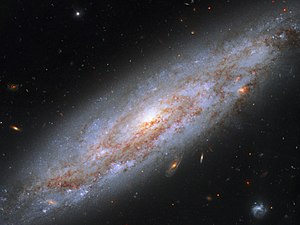NGC 3972
| Galaxie NGC 3972 | |
|---|---|
(c) ESA/Hubble, CC BY 4.0 | |
| Aufnahme der Galaxie NGC 3972, Hubble-Weltraumteleskop | |
| AladinLite | |
| Sternbild | Großer Bär |
| Position Äquinoktium: J2000.0, Epoche: J2000.0 | |
| Rektaszension | 11h 55m 45,1s[1] |
| Deklination | +55° 19′ 15″[1] |
| Erscheinungsbild | |
| Morphologischer Typ | SA(s)bc[1] |
| Helligkeit (visuell) | 12,1 mag[2] |
| Helligkeit (B-Band) | 12,9 mag[2] |
| Winkelausdehnung | 3,7′ × 1′[2] |
| Positionswinkel | 120°[2] |
| Flächenhelligkeit | 13,4 mag/arcmin²[2] |
| Physikalische Daten | |
| Zugehörigkeit | LGG 241[1][3] |
| Rotverschiebung | 0.002843 ± 0.000005[1] |
| Radialgeschwindigkeit | (852 ± 1) km/s[1] |
| Hubbledistanz H0 = 73 km/(s • Mpc) | (42 ± 3) · 106 Lj (12,8 ± 0,9) Mpc [1] |
| Geschichte | |
| Entdeckung | Wilhelm Herschel |
| Entdeckungsdatum | 14. April 1789 |
| Katalogbezeichnungen | |
| NGC 3972 • UGC 6904 • PGC 37466 • CGCG 269-016 • MCG +09-20-032 • IRAS 11531+5535 • 2MASX J11554511+5519144 • GC 2618 • H II 789 • LDCE 0867 NED049 | |
NGC 3972 ist eine Balken-Spiralgalaxie vom Typ SBbc im Sternbild Großer Bär am Nordsternhimmel, die schätzungsweise 42 Millionen Lichtjahre von der Milchstraße entfernt ist.
Die Galaxie wurde von dem Astronomen William Herschel am 14. April 1789 mithilfe seines 18,7 Zoll Teleskops entdeckt.[4]
Am 26. April 2011 wurde von Zhangwei Jin (Ningbo, Zhejiang, China) und Xing Gao (Urumqi, Xinjiang, China) eine Supernova vom Typ Ia nördlich des Zentrums von NGC 3927 entdeckt.[5]
Weblinks
Einzelnachweise
Auf dieser Seite verwendete Medien
(c) ESA/Hubble, CC BY 4.0
Galaxy full of cosmic lighthouses
This enchanting spiral galaxy can be found in the constellation of Ursa Major (the Great Bear). Star-studded NGC 3972 lies about 65 million light-years away from the Earth, meaning that the light that we see now left it 65 million years ago, just when the dinosaurs became extinct.
NGC 3972 has had its fair share of dramatic events. In 2011 astronomers observed the explosion of a type Ia supernova in the galaxy (not visible in this image). These dazzling objects all peak at the same brightness, and are brilliant enough to be seen over large distances. NGC 3972 also contains many pulsating stars called Cepheid variables. These stars change their brightness at a rate matched closely to their intrinsic luminosity, making them ideal cosmic lighthouses for measuring accurate distances to relatively nearby galaxies.
Astronomers search for Cepheid variables in nearby galaxies which also contain a type Ia supernova so they can compare the true brightness of both types of stars. That brightness information is used to calibrate the luminosity of Type Ia supernovae in far-flung galaxies so that astronomers can calculate the galaxies' distances from Earth. Once astronomers know accurate distances to galaxies near and far, they can determine and refine the expansion rate of the Universe.
This image was taken in 2015 with Hubble’s Wide Field Camera 3, as part of a project to improve the precision of the Hubble constant — a figure that describes the expansion rate of the Universe.
Credit:
NASA, ESA, A. Riess (STScI/JHU)
